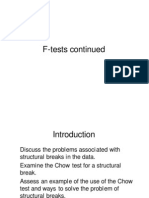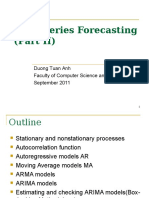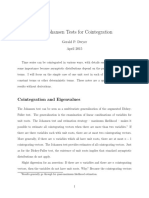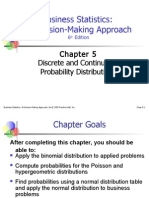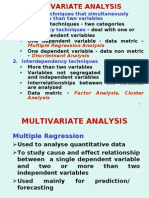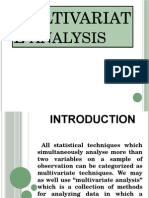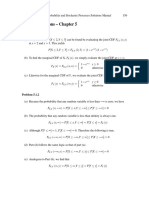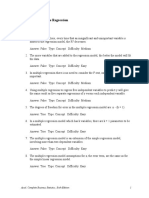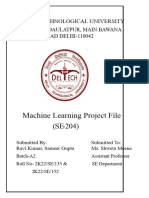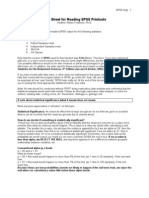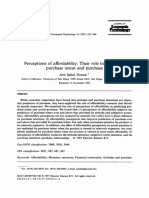Multiple Regression
Uploaded by
kuashask2Multiple Regression
Uploaded by
kuashask2ASA University Bangladesh Md.
Tareq Ferdous Khan
A S A
U NIV ER SIT Y BANGLADESH
Lecturer, Faculty of Business Regression Analysis The regression analysis is a technique of analyzing or studying the dependence of one variable (called dependent variable), on one or more variables (called explanatory variables), with a view to estimating and or predicting the population mean or average value of the former in terms of the known or fixed values of the latter. Uses of Regression Analysis 1. Estimate the relationship that exists, on the average, between the dependent and the explanatory variables. 2. Determine the effect of each of the explanatory variables on the dependent variable, controlling the effects of all other explanatory variables. 3. Predict the value of the dependent variable for a given value of the explanatory variable. Multiple Regression Model The regression equation that describes how the dependent variable related to the independent or explanatory variables error term is
and an
is called the multiple regression model. The multiple independent variables can be written as:
regression model with
where,
the value of dependent variable s = the value of ith independent variable, intercept the regression coefficients the random error component
Multiple Regression Equation
ASA University Bangladesh Md. Tareq Ferdous Khan
A S A
U NIV ER SIT Y BANGLADESH
Lecturer, Faculty of Business The equation that describes how the mean value of independent or explanatory variables is related to the
is called the multiple independent
regression equation. The multiple regression equation with variables can be written as:
where, variable
the mean or expected value of the dependent
s = the value of ith independent variable, intercept the regression coefficients
Estimated Multiple Regression Equation Generally, the parameters , are unknown in the regression
model. The ordinary least square (OLS) method is used to estimate the parameters based on the sample observations. The estimated values of the parameters provide the following estimated multiple regression equation:
where,
are the estimates of , is the estimated value of the dependent variable.
and
In generally, the estimated equation of the multiple regression model by ordinary least square method based on sample observations is known as estimated multiple regression equation.
ASA University Bangladesh Md. Tareq Ferdous Khan
A S A
U NIV ER SIT Y BANGLADESH
Lecturer, Faculty of Business Assumptions about the Error Term Model In order to estimate the unknown parameter by OLS, the error term should satisfy the following assumptions:
in the Multiple Regression
The error
is a random variable with mean or expected value . , is the same for all values of
of zero. That is
The variance of , denoted by the independent variable. The values of The error
are independent.
is a normally distributed random variable.
Relationship among SST, SSR and SSE In multiple regression analysis, the total sum of squares (SST) can be partitioned into two components: the sum of squares due to regression (SSR) and the sum of squares due to error (SSE). The relationship among them is given below: SST = SSR + SSE where, SST = total sum of squares = SSR = sum of squares due to regression = SSE = sum of squares due to error = Multiple Coefficient of Determination The multiple coefficient of determination is defined as the ratio of sum of squares due to regression (SSR) and sum of squares due to error (SSE). It is used to evaluate the goodness of fit for the estimated regression equation. It is denoted by and mathematically can be written as:
ASA University Bangladesh Md. Tareq Ferdous Khan
A S A
U NIV ER SIT Y BANGLADESH
Lecturer, Faculty of Business
The multiple coefficient of determination
can be interpreted as the
proportion of the variability in the independent variable that can be explained by the estimated multiple regression equation. Adjusted Multiple Coefficient of Determination The adjusted multiple coefficient of determination can be calculated as:
where,
= adjusted multiple coefficient of determination = multiple coefficient of determination = number of observations = number of regression coefficient including intercept.
Example 1 Butler Trucking Company, an independent trucking company in southern California involves deliveries throughout its local area. To develop the better work schedule, the manager wants to estimate the total daily travel time for their drivers. Initially, the manager believed that the total travel time would be closely related to the number of miles traveled and number of deliveries. A simple random sample of 10 drivers provided the information about total daily travel time (in hours), miles travel and number of deliveries. The multiple regression output is given below:
Predictor Constant miles deliveri S = 0.5731 Coef -0.8687 0.061135 0.9234 SE Coef 0.9515 0.009888 0.2211 T -0.91 6.18 4.18 P 0.392 0.000 0.004
R-Sq = 90.4%
R-Sq(adj) = 87.6%
Analysis of Variance Source Regression Residual Error Total DF 2 7 9 SS 21.601 2.299 23.900 MS 10.800 0.328 F 32.88 P 0.000
ASA University Bangladesh Md. Tareq Ferdous Khan
A S A
U NIV ER SIT Y BANGLADESH
Lecturer, Faculty of Business a) Develop the regression model of travel time (hours) on miles traveled and number of deliveries. b) Write down the estimated regression equation interpretation on the regression coefficients. and make
c) Make a comment on the goodness of fit of the estimated regression equation. d) Test whether there is a significant effect of miles travel on travel times at 5% level of significance. e) Test whether there is a significant effect of number of deliveries on travel times at 5% level of significance. f) Test whether the overall relationship between travel time and the set of independent variables miles travel and number of deliveries is significant at 5% level of significance. g) Estimate travel time hours when miles travel and number of deliveries are 70 and 4 respectively. Solution a) The regression model of travel time (hours) on miles traveled and number of deliveries can be written as:
where,
= the value of travel time (hours) = intercept are the regression coefficients = the value of miles travel = the value of number of deliveries = random error component
Alternative: The regression model of travel time (hours) on miles traveled and number of deliveries can be written as:
ASA University Bangladesh Md. Tareq Ferdous Khan
A S A
U NIV ER SIT Y BANGLADESH
Lecturer, Faculty of Business where, same as above
b) The estimated regression equation from the given output will be
(or Interpretation
The estimated coefficient 0.0611 indicates that for an increase of one mile in the distance traveled, the expected travel time will increase by 0.0611 hours when the number of deliveries is held constant. The estimated coefficient 0.9231 indicates that for an increase of one delivery, the expected travel time will increase by 0.9231 hours when the number of miles traveled is held constant. c) From the output, we have which indicates that 90.4% of the
variability in travel time is explained by the estimated multiple regression equation with miles traveled and number of deliveries as the independent variables. Or from the adjusted we may conclude that 87.6% of the variability in
travel time is explained by the estimated multiple regression equation with miles traveled and number of deliveries as the independent variables. d) Critical Value Approach: In order to know whether there is a significant effect of miles traveled on travel time, we need to test the following hypothesis: against
ASA University Bangladesh Md. Tareq Ferdous Khan
A S A
U NIV ER SIT Y BANGLADESH
Lecturer, Faculty of Business
Under the null hypothesis, the value of test statistic is given as:
The critical value of
is
As
, we may reject the null hypothesis.
From the hypothesis test, we may conclude that there is a significant effect of miles travelled on travel time (hours). p Value Approach: In order to know whether there is a significant effect of miles traveled on travel time, we need to test the following hypothesis: against
From the output, we have
As p value
0.05, we may reject the null hypothesis.
From the hypothesis test, we may conclude that there is a significant effect of miles travelled on travel time (hours). e) Critical Value Approach: In order to know whether there is a significant effect of number of deliveries on travel time, we need to test the following hypothesis: against
ASA University Bangladesh Md. Tareq Ferdous Khan
A S A
U NIV ER SIT Y BANGLADESH
Lecturer, Faculty of Business Under the null hypothesis, the value of test statistic is given as:
The critical value of
is
As
, we may reject the null hypothesis.
From the hypothesis test, we may conclude that there is a significant effect of number of deliveries on travel time (hours). p Value Approach: In order to know whether there is a significant effect of number of deliveries on travel time, we need to test the following hypothesis: against
From the output, we have
As p value
0.05, we may reject the null hypothesis.
From the hypothesis test, we may conclude that there is a significant effect of number of deliveries on travel time (hours). f) Critical Value Approach: To test whether the overall relationship between travel time and the set of independent variables miles travel and number of deliveries is significant or not, we need to test the following hypothesis: against
ASA University Bangladesh Md. Tareq Ferdous Khan
A S A
U NIV ER SIT Y BANGLADESH
Lecturer, Faculty of Business Under the null hypothesis, the value of test statistic is given as:
The critical value of F is
As
, we may reject the null hypothesis.
From the hypothesis test, we may conclude that there is a significant overall relationship between travel time and the set of independent variables miles travel and number of deliveries. p Value Approach: To test whether the overall relationship between travel time and the set of independent variables miles travel and number of deliveries is significant or not, we need to test the following hypothesis: against
From the output, we have
As p value
0.05, we may reject the null hypothesis.
From the hypothesis test, we may conclude that there is a significant overall relationship between travel time and the set of independent variables miles travel and number of deliveries. g) The estimated travel time when miles travel and number of deliveries are respectively 70 and 4 will be
ASA University Bangladesh Md. Tareq Ferdous Khan
A S A
U NIV ER SIT Y BANGLADESH
Lecturer, Faculty of Business Hence we can say that the estimated travel time will be 8.84 hours if the driver wants to travel 70 miles and give 4 deliveries. Example 1 Consider the following data for a dependent variable independent variables and . and two
96 90 95 92 94
5.0 2.0 4.0 2.5 3.5
1.5 2.0 1.5 2.5 3.3
The estimated regression equation based on 5 observations is
a) Compute the total sum of squares (SST), sum of squares due to regression (SSR), and sum of squares due error (SSE).
b) Find the value of
and adjusted
. Comment on the goodness of fit.
c) Compute F and perform the appropriate F test at 5% level of significance. Solution a) We know that, Total sum of squares (SST) = Sum of squares due to regression (SSR) = Sum of squares due to error (SSE) = SST = SSR + SSE Calculation Table: and
96
5.0
1.5
96.43
6.76
9.15
ASA University Bangladesh Md. Tareq Ferdous Khan
A S A
U NIV ER SIT Y BANGLADESH
Lecturer, Faculty 90 95 92 94
of Business 2.0 2.0 4.0 1.5 2.5 2.5 3.5 3.3
90.44 94.37 91.67 94.04
11.56 2.56 1.96 0.36 =23.20
8.76 0.93 3.01 0.41 =22.26
93.40
Hence,
Total sum of squares (SST) = 23.20 Sum of squares due to regression (SSR) = 22.26 Sum of squares due to error (SSE) = SST SSR = 23.20 22.26 = 0.94 b)
The multiple coefficient of determination (
0.96
Comment: The
value indicates that the 96% of the variability in y can
be explained by the estimated regression equation with independent variables and .
The adjusted
will be
Comment: The adjusted
value indicates that the 92% of the variability
in y can be explained by the estimated regression equation with independent variables and .
c) We need to test the following hypothesis:
ASA University Bangladesh Md. Tareq Ferdous Khan
A S A
U NIV ER SIT Y BANGLADESH
Lecturer, Faculty of Business against
Test Statistic: Under the null hypothesis, the test statistic will be
Critical Value: The critical value of F with degrees of freedom 2 and 2 will be
Decision rule: As , we may reject the null hypothesis.
Comment: From the hypothesis test, we may conclude that at least one parameter is not equal to zero.
You might also like
- Hypothesis Testing - Analysis of Variance (ANOVA)No ratings yetHypothesis Testing - Analysis of Variance (ANOVA)14 pages
- The Exponential Family of Distributions: P (X) H (X) eNo ratings yetThe Exponential Family of Distributions: P (X) H (X) e13 pages
- The Impact of Non-Performing Loans and Bank Performance in NigeriaNo ratings yetThe Impact of Non-Performing Loans and Bank Performance in Nigeria5 pages
- Biometrika Trust, Oxford University Press BiometrikaNo ratings yetBiometrika Trust, Oxford University Press Biometrika22 pages
- Handleiding Spss Multinomial Logit RegressionNo ratings yetHandleiding Spss Multinomial Logit Regression35 pages
- Notes On Stochastic Processes: 1 Learning OutcomesNo ratings yetNotes On Stochastic Processes: 1 Learning Outcomes26 pages
- Poisson Regression - Stata Data Analysis ExamplesNo ratings yetPoisson Regression - Stata Data Analysis Examples12 pages
- Analysis Analysis: Multivariat E Multivariat ENo ratings yetAnalysis Analysis: Multivariat E Multivariat E12 pages
- 1 Markov Chains: Indian Institute of Technology BombayNo ratings yet1 Markov Chains: Indian Institute of Technology Bombay15 pages
- Lecture 10 Randomized Complete Block Design Last Lecture100% (1)Lecture 10 Randomized Complete Block Design Last Lecture4 pages
- Regression With Dummy Variables Econ420 1No ratings yetRegression With Dummy Variables Econ420 147 pages
- Sampling: Gaurav Kumar Prajapat Sr. Audit Officer O/O Ag (Audit-Ii), Rajasthan JaipurNo ratings yetSampling: Gaurav Kumar Prajapat Sr. Audit Officer O/O Ag (Audit-Ii), Rajasthan Jaipur61 pages
- App.A - Detection and Estimation in Additive Gaussian Noise PDFNo ratings yetApp.A - Detection and Estimation in Additive Gaussian Noise PDF55 pages
- Kaplan-Meier Estimator: Association. The Journal Editor, John Tukey, Convinced Them To Combine TheirNo ratings yetKaplan-Meier Estimator: Association. The Journal Editor, John Tukey, Convinced Them To Combine Their7 pages
- Co-Integration and Error Correction ModelNo ratings yetCo-Integration and Error Correction Model4 pages
- Department of Economics: ECONOMICS 481: Economics Research Paper and SeminarNo ratings yetDepartment of Economics: ECONOMICS 481: Economics Research Paper and Seminar15 pages
- Research Methodology - Parametric and Non-Parametric TestsNo ratings yetResearch Methodology - Parametric and Non-Parametric Tests7 pages
- Review of Multiple Regression: Assumptions About Prior Knowledge. This Handout Attempts To Summarize and SynthesizeNo ratings yetReview of Multiple Regression: Assumptions About Prior Knowledge. This Handout Attempts To Summarize and Synthesize12 pages
- BUS 5110 Managerial Accounting Unit 4 WRNo ratings yetBUS 5110 Managerial Accounting Unit 4 WR5 pages
- Chapter-1: Introduction: 1.1 Context and Background of The StudyNo ratings yetChapter-1: Introduction: 1.1 Context and Background of The Study6 pages
- Written Assignment Unit 3 - Analysis of Parasailing Business ExpansionNo ratings yetWritten Assignment Unit 3 - Analysis of Parasailing Business Expansion5 pages
- Chapter 05: Overall Evaluation of Investment Policies of SiblNo ratings yetChapter 05: Overall Evaluation of Investment Policies of Sibl3 pages
- ASA University Bangladesh (ASAUB) Faculty of Business: 1. 2. 3. 4. 5. 6. 7. 8. 9. 10. Chapter OneNo ratings yetASA University Bangladesh (ASAUB) Faculty of Business: 1. 2. 3. 4. 5. 6. 7. 8. 9. 10. Chapter One4 pages
- For The Years 2018-22 Department of Business Administration ASA University BangladeshNo ratings yetFor The Years 2018-22 Department of Business Administration ASA University Bangladesh14 pages
- ASA University Bangladesh: Jessore BoardNo ratings yetASA University Bangladesh: Jessore Board2 pages
- Bangladesh University of Professionals (BUP) : Mirpur Cantonment, Dhaka - 12160% (1)Bangladesh University of Professionals (BUP) : Mirpur Cantonment, Dhaka - 12162 pages
- 285 08-1-14-0142 Md. Riad Hasan Fall 2009No ratings yet285 08-1-14-0142 Md. Riad Hasan Fall 20094 pages
- Allocation of Researchers Topic To Faculties Bangladesh University of Professionals (Bup)100% (1)Allocation of Researchers Topic To Faculties Bangladesh University of Professionals (Bup)10 pages
- Books On Economics For Serious BeginnersNo ratings yetBooks On Economics For Serious Beginners2 pages
- Name: - ECO 340 820 Banking & Financial Markets Homework #2, Due Monday, 2/18No ratings yetName: - ECO 340 820 Banking & Financial Markets Homework #2, Due Monday, 2/182 pages
- Introduction To Logistic Regression: Rachid Salmi, Jean-Claude Desenclos, Alain Moren, Thomas GreinNo ratings yetIntroduction To Logistic Regression: Rachid Salmi, Jean-Claude Desenclos, Alain Moren, Thomas Grein36 pages
- Brand Counter Extensions The Impact of Brand Extension Success Versus FailureNo ratings yetBrand Counter Extensions The Impact of Brand Extension Success Versus Failure13 pages
- Mankiw PrinciplesOfEconomics 10e PPT CH38No ratings yetMankiw PrinciplesOfEconomics 10e PPT CH3843 pages
- MVDCMP: Multivariate Decomposition For Nonlinear Response ModelsNo ratings yetMVDCMP: Multivariate Decomposition For Nonlinear Response Models21 pages
- Samman Mohammadi, Mohammad Monfared Maharlouie, Dan Omid Mansouri. 2012. The Effect of Cash Holdings On Income Smoothing PDFNo ratings yetSamman Mohammadi, Mohammad Monfared Maharlouie, Dan Omid Mansouri. 2012. The Effect of Cash Holdings On Income Smoothing PDF10 pages
- Exploring The Role of Social Media Use Motives, Psychological Well-Being, Self-Esteem, and Affect in Problematic Social Media UseNo ratings yetExploring The Role of Social Media Use Motives, Psychological Well-Being, Self-Esteem, and Affect in Problematic Social Media Use10 pages
- Does Forensic Audit Influence Fraud Control Evidence From Nigerian Deposit Money BanksNo ratings yetDoes Forensic Audit Influence Fraud Control Evidence From Nigerian Deposit Money Banks17 pages
- The Landscape of R Packages For Automated Exploratory Data AnalysisNo ratings yetThe Landscape of R Packages For Automated Exploratory Data Analysis19 pages
- Instant Ebooks Textbook Statistics For Criminology and Criminal Justice Jacinta M. Gau Download All Chapters100% (3)Instant Ebooks Textbook Statistics For Criminology and Criminal Justice Jacinta M. Gau Download All Chapters62 pages
- Elsevier - First and Second Order Sensitivity Analysis of MLPNo ratings yetElsevier - First and Second Order Sensitivity Analysis of MLP9 pages
- Ebooks File Regression, A Friendly Guide (MEAP V03) Matthew Rudd All ChaptersNo ratings yetEbooks File Regression, A Friendly Guide (MEAP V03) Matthew Rudd All Chapters49 pages
- Total Quality Management (TQM) ImplementationNo ratings yetTotal Quality Management (TQM) Implementation23 pages
- Perceptions of Affordability: Their Role in Predicting Purchase Intent and PurchaseNo ratings yetPerceptions of Affordability: Their Role in Predicting Purchase Intent and Purchase22 pages
- The Exponential Family of Distributions: P (X) H (X) eThe Exponential Family of Distributions: P (X) H (X) e
- The Impact of Non-Performing Loans and Bank Performance in NigeriaThe Impact of Non-Performing Loans and Bank Performance in Nigeria
- Biometrika Trust, Oxford University Press BiometrikaBiometrika Trust, Oxford University Press Biometrika
- Notes On Stochastic Processes: 1 Learning OutcomesNotes On Stochastic Processes: 1 Learning Outcomes
- 1 Markov Chains: Indian Institute of Technology Bombay1 Markov Chains: Indian Institute of Technology Bombay
- Lecture 10 Randomized Complete Block Design Last LectureLecture 10 Randomized Complete Block Design Last Lecture
- Sampling: Gaurav Kumar Prajapat Sr. Audit Officer O/O Ag (Audit-Ii), Rajasthan JaipurSampling: Gaurav Kumar Prajapat Sr. Audit Officer O/O Ag (Audit-Ii), Rajasthan Jaipur
- App.A - Detection and Estimation in Additive Gaussian Noise PDFApp.A - Detection and Estimation in Additive Gaussian Noise PDF
- Kaplan-Meier Estimator: Association. The Journal Editor, John Tukey, Convinced Them To Combine TheirKaplan-Meier Estimator: Association. The Journal Editor, John Tukey, Convinced Them To Combine Their
- Department of Economics: ECONOMICS 481: Economics Research Paper and SeminarDepartment of Economics: ECONOMICS 481: Economics Research Paper and Seminar
- Research Methodology - Parametric and Non-Parametric TestsResearch Methodology - Parametric and Non-Parametric Tests
- Review of Multiple Regression: Assumptions About Prior Knowledge. This Handout Attempts To Summarize and SynthesizeReview of Multiple Regression: Assumptions About Prior Knowledge. This Handout Attempts To Summarize and Synthesize
- Chapter-1: Introduction: 1.1 Context and Background of The StudyChapter-1: Introduction: 1.1 Context and Background of The Study
- Written Assignment Unit 3 - Analysis of Parasailing Business ExpansionWritten Assignment Unit 3 - Analysis of Parasailing Business Expansion
- Chapter 05: Overall Evaluation of Investment Policies of SiblChapter 05: Overall Evaluation of Investment Policies of Sibl
- ASA University Bangladesh (ASAUB) Faculty of Business: 1. 2. 3. 4. 5. 6. 7. 8. 9. 10. Chapter OneASA University Bangladesh (ASAUB) Faculty of Business: 1. 2. 3. 4. 5. 6. 7. 8. 9. 10. Chapter One
- For The Years 2018-22 Department of Business Administration ASA University BangladeshFor The Years 2018-22 Department of Business Administration ASA University Bangladesh
- Bangladesh University of Professionals (BUP) : Mirpur Cantonment, Dhaka - 1216Bangladesh University of Professionals (BUP) : Mirpur Cantonment, Dhaka - 1216
- Allocation of Researchers Topic To Faculties Bangladesh University of Professionals (Bup)Allocation of Researchers Topic To Faculties Bangladesh University of Professionals (Bup)
- Name: - ECO 340 820 Banking & Financial Markets Homework #2, Due Monday, 2/18Name: - ECO 340 820 Banking & Financial Markets Homework #2, Due Monday, 2/18
- Introduction To Logistic Regression: Rachid Salmi, Jean-Claude Desenclos, Alain Moren, Thomas GreinIntroduction To Logistic Regression: Rachid Salmi, Jean-Claude Desenclos, Alain Moren, Thomas Grein
- Brand Counter Extensions The Impact of Brand Extension Success Versus FailureBrand Counter Extensions The Impact of Brand Extension Success Versus Failure
- MVDCMP: Multivariate Decomposition For Nonlinear Response ModelsMVDCMP: Multivariate Decomposition For Nonlinear Response Models
- Samman Mohammadi, Mohammad Monfared Maharlouie, Dan Omid Mansouri. 2012. The Effect of Cash Holdings On Income Smoothing PDFSamman Mohammadi, Mohammad Monfared Maharlouie, Dan Omid Mansouri. 2012. The Effect of Cash Holdings On Income Smoothing PDF
- Exploring The Role of Social Media Use Motives, Psychological Well-Being, Self-Esteem, and Affect in Problematic Social Media UseExploring The Role of Social Media Use Motives, Psychological Well-Being, Self-Esteem, and Affect in Problematic Social Media Use
- Does Forensic Audit Influence Fraud Control Evidence From Nigerian Deposit Money BanksDoes Forensic Audit Influence Fraud Control Evidence From Nigerian Deposit Money Banks
- The Landscape of R Packages For Automated Exploratory Data AnalysisThe Landscape of R Packages For Automated Exploratory Data Analysis
- Instant Ebooks Textbook Statistics For Criminology and Criminal Justice Jacinta M. Gau Download All ChaptersInstant Ebooks Textbook Statistics For Criminology and Criminal Justice Jacinta M. Gau Download All Chapters
- Elsevier - First and Second Order Sensitivity Analysis of MLPElsevier - First and Second Order Sensitivity Analysis of MLP
- Ebooks File Regression, A Friendly Guide (MEAP V03) Matthew Rudd All ChaptersEbooks File Regression, A Friendly Guide (MEAP V03) Matthew Rudd All Chapters
- Perceptions of Affordability: Their Role in Predicting Purchase Intent and PurchasePerceptions of Affordability: Their Role in Predicting Purchase Intent and Purchase






